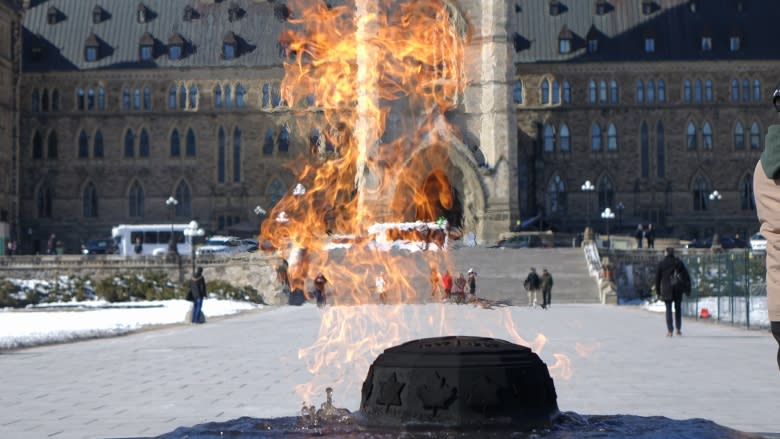'Greening' project could end use of fossil fuel for Centennial Flame
Will the Centennial Flame monument on Parliament Hill, with its dancing fires lit by natural gas, become the Centennial LED?
The federal government has launched a study of options to cut the flow of natural gas from Western Canada to the popular monument, and replace it with a more eco-friendly energy source.
Natural gas piped from the West has been bubbling through the fountain in the centre of the monument for 50 years, ever since it was unveiled by then-prime minister Lester Pearson on the eve of July 1, 1967, Confederation's 100th birthday.
But Public Services and Procurement Canada has launched a project called the 'Greening of the Centennial Flame' to reduce or eliminate its greenhouse gas emissions.
Natural gas is mostly methane, and burning it produces carbon dioxide – a greenhouse gas blamed for global warming. Methane itself is a much more potent greenhouse gas, and incomplete burning of methane can also contribute to climate change.
'Net-zero'
Last September, the department began paying Bullfrog Power about $20,000 a year for an arrangement billed as a "net-zero" for carbon-dioxide emissions.
The centennial monument still burns Western Canadian natural gas, supplied by Calgary-based Enbridge. But Bullfrog Power now supplies the natural gas distribution system with bio-methane in an amount equal to the natural gas being burned in the monument. It adds the bio-methane — sometimes called 'biogas' — to existing natural-gas pipeline networks as an offset to the emissions generated by burning natural gas in the monument.
Bullfrog gets its biogas from a Quebec facility that draws on the renewable methane produced by rotting food and other organic matter in landfills north of Montreal. Methane often escapes landfills, and tapping landfill emissions for fuel can help reduce the total amount of carbon introduced to the atmosphere.
"Unlike fossil fuel-based natural gas, it does not increase the amount of carbon dioxide in the atmosphere and is considered a net-zero carbon dioxide emitting energy source that can be consumed without contributing to climate change," said Public Services spokesman Jean-Francois Letourneau.
But the department wants to "explore options to actually change the energy source," says an internal document obtained by CBC News under the Access to Information Act.
The document cites "other carbon-neutral fuels, electricity, LED lighting, etc." as possible replacements for Western Canadian natural gas, without providing details.
Letourneau confirmed the department is examining alternatives.
"A study to define options for a long-term sustainable alternative source to fuel the Centennial Flame is underway and is targeted for completion in fall 2018," he said in an email.
Recently overhauled
The department operates other facilities in Ottawa that draw on natural gas, including the Cliff Heating and Cooling Plant just west of Parliament Hill, but has no similar arrangements with Bullfrog for "net-zero" carbon emissions for those facilities.
The Centennial Flame was overhauled recently as Public Services gave the monument a 13th wedge to represent Nunavut. The northern territory was created in 1999, long after the structure was built in 1966 with 12 wedges symbolizing the 10 provinces and two territories.
The project last year cost at least $845,000. Almost every piece of the original monument was replaced with newer materials.
The original Centennial Flame was considered a temporary, one-year installation for 1967 but proved so popular it was kept in place.
The 2017 overhaul cost $85,000 in management fees, $105,000 for design work, $640,000 for construction (including labour) and another $15,000 for various related costs.
Follow @DeanBeeby on Twitter




